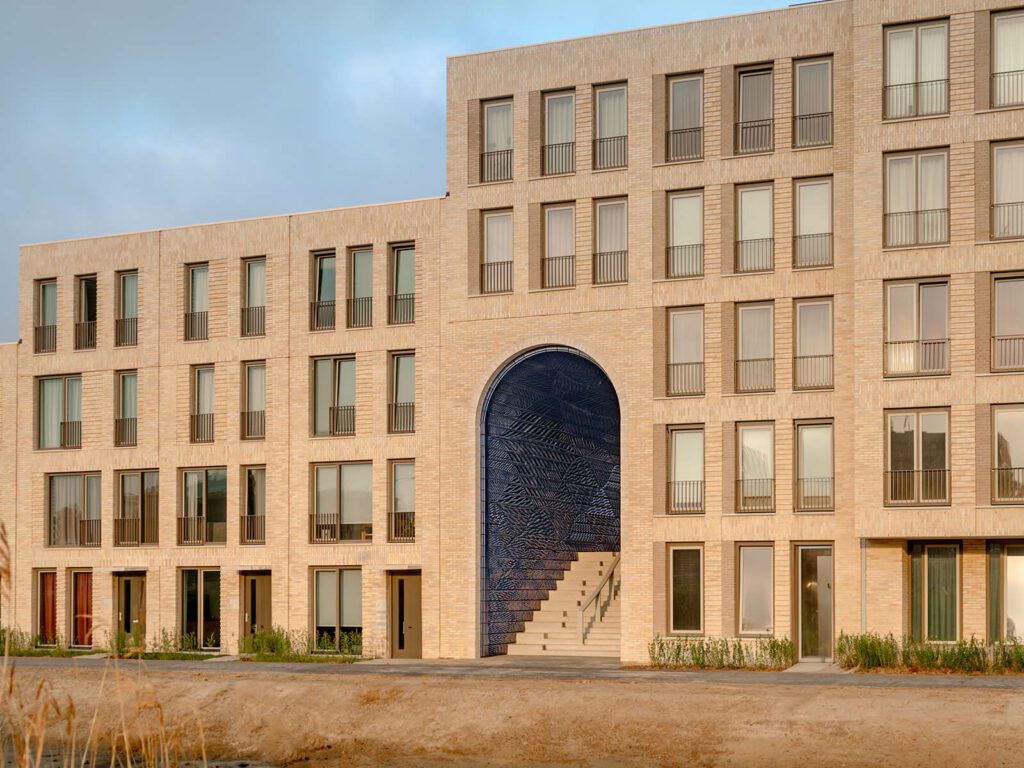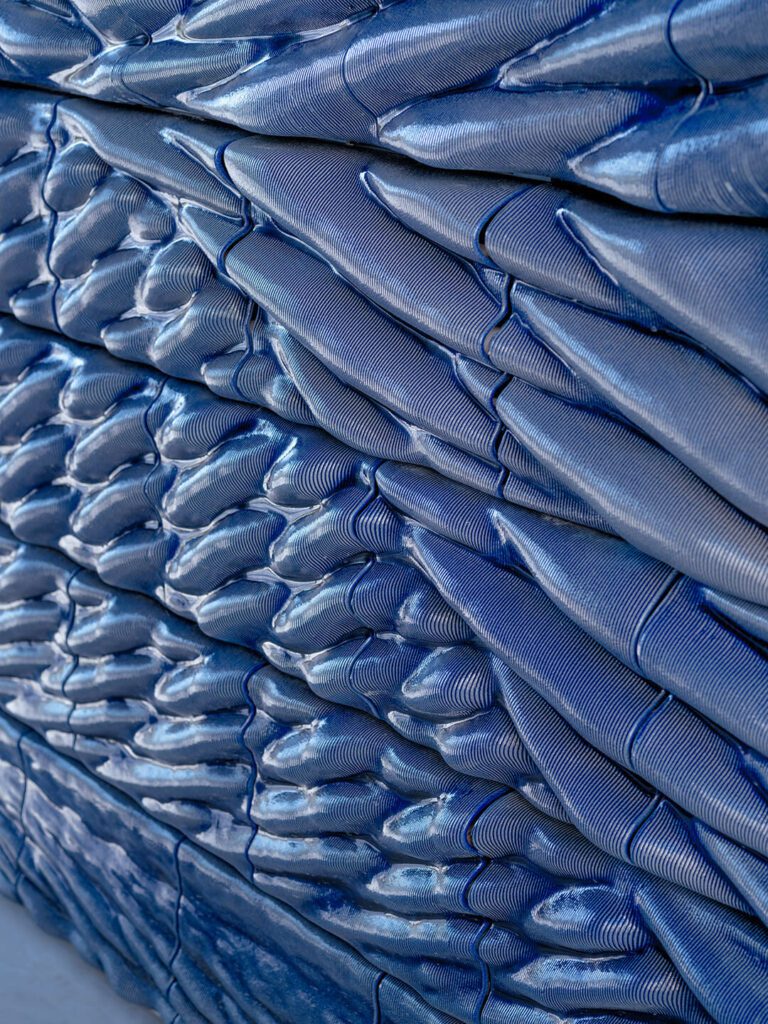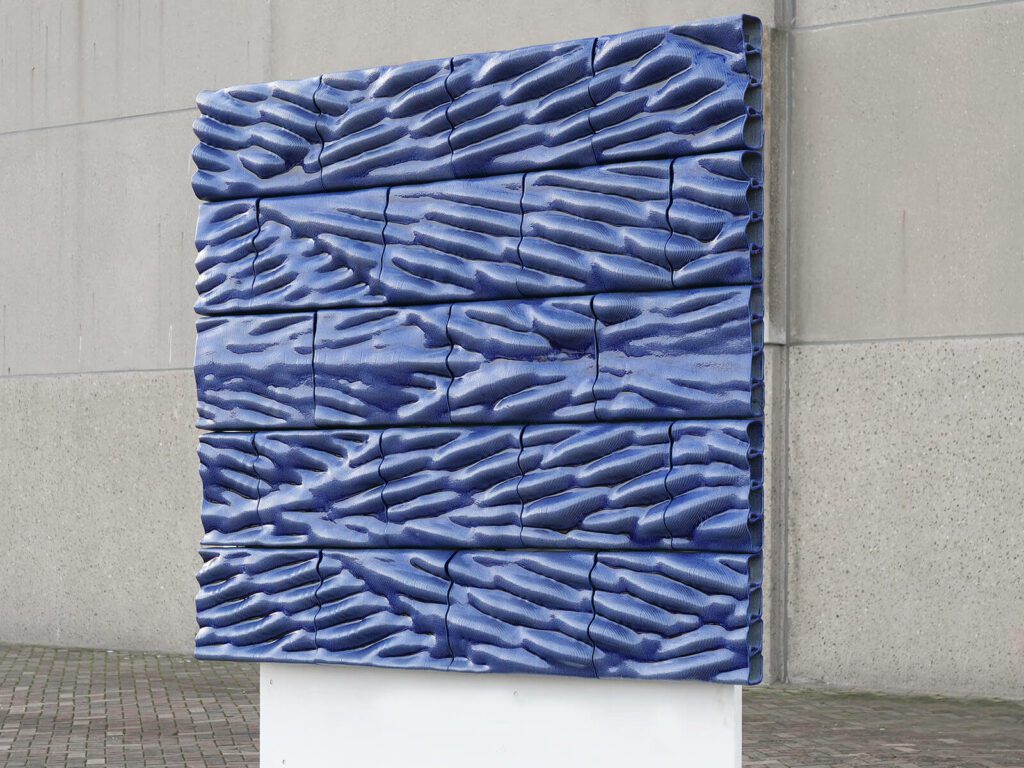The application of 3D printing in adaptive reuse and the restoration of heritage buildings presents unprecedented opportunities to merge tradition and technology. In our urban landscapes, where historical structures are often neglected or demolished due to high repair costs, 3D scanning and printing offer data accuracy, cost and time efficiency, sustainability, and customization potential. This technology enables these structures to gain new identities and relevance in contemporary times, preserving cultural heritage while embracing modern advancements.
In regard to the growing trend, Studio RAP, a Rotterdam-based architectural firm, has recently unveiled an innovative project, New Delft Blue, that melds the historic charm of Delft Blue ceramics with cutting-edge 3D printing technology. This project stands as a testament to how contemporary techniques can breathe new life into urban landscapes while preserving and celebrating cultural heritage.
Printed Archways Unify Nieuw Delft’s Urban Landscape
New Delft Blue is part of a larger urban development project aimed at urbanisation Nieuw Delft, a city area previously divided by a railway viaduct. The viaduct has been replaced by a vibrant 24-hectare urban environment that aims to reunite the city. At the heart of this transformation are two grand archways adorned with 3D-printed ceramic tiles glazed in a deep blue hue, reminiscent of traditional Delft Blue porcelain.
Studio RAP, known for its integration of computational design and digital fabrication, took inspiration from the iconic Delft Blue plates. These plates, famous for their intricate blue and white designs, have been reinterpreted in the project’s modern aesthetic. The archways not only serve as gateways to the PoortMeesters residential block but also as a bridge between the past and present, showcasing the potential of adaptive reuse in architecture.

Digital Fabrication Meets Traditional Craftsmanship
The project leverages 3D printing technology to create 3000 unique ceramic tiles that clad the archways. Each tile is digitally designed and fabricated, ensuring precision and reducing error margins. This method significantly cuts construction costs and time while allowing for a high degree of customization. The tiles feature organic patterns with convex and concave folds, creating waves of rich blue glaze that intensify at the depressions and soften on the convex folds. This variation in form and color allows the designers to “paint with shapes,” resulting in a dynamic and visually striking façade.
Studio RAP’s digital fabrication setup is sophisticated, combining robotic production with artisanal glazing techniques. Koninklijke Tichelaar, a renowned ceramic glazing and firing company, was responsible for the intricate glazing process, ensuring that each tile’s unique design was perfectly realized. The tiles’ textural crests and troughs highlight the meticulous craftsmanship involved, contrasting beautifully against the warm yellow brickwork of the PoortMeesters building.
Innovative Design for Urban Regeneration
New Delft Blue is more than just an architectural project; it’s a statement on the role of technology in preserving cultural heritage and enhancing urban spaces. By integrating 3D printing into the construction process, Studio RAP demonstrates the potential for digital technologies to revolutionize the way we approach building and restoration.
The project also highlights the importance of community involvement in urban regeneration. The larger Nieuw Delft development includes Van Leeuwenhoek Park, which occupies the former railway’s ground. The park’s design was shaped by suggestions from local residents and stakeholders, fostering a sense of ownership and belonging. This community-centric approach ensures that urban interventions are not only aesthetically pleasing but also socially relevant and inclusive.

A Symbol of Modernity and Tradition
The New Delft Blue archways, standing eight meters tall and twelve meters deep, encase a public staircase and serve as a focal point for the PoortMeesters residential complex. The visual inspiration for the project comes from the courtyard’s private gardens, rainwater storage systems, trees, and large shrubs, all reminiscent of the idyllic scenes depicted on traditional Delft Blue porcelain. This biophilic design approach integrates nature with architecture, promoting a harmonious and sustainable living environment.
The project’s success lies in its ability to merge historical ornamentation with modern technology seamlessly. By doing so, it creates a new identity for Delft, one that respects its rich cultural heritage while embracing contemporary innovation. This fusion of past and present is what makes New Delft Blue a true urban activator, capable of sparking conversations about the role of historical structures in today’s cities.
Economic and Cultural Impact
Retrofitted historical buildings and new urban inserts developed with 3D technology have the potential to become visual landmarks and cultural attractions. Projects like New Delft Blue can drive economic growth by boosting tourism, fostering creative industries, and hosting social and cultural events. These interventions can transform urban spaces into vibrant socio-cultural hubs, promoting community pride and engagement.
The success of New Delft Blue is a testament to the collaborative efforts of a diverse team at Studio RAP, including architects, roboticists, programmers, designers, and researchers. Their combined expertise in computational design and digital fabrication has redefined the role of the architect, blending architecture with entrepreneurship, manufacturing, and craftsmanship.

Restoration and Adaptive Reuse: A New Era in Architecture
The innovative use of 3D printing in New Delft Blue also opens up new possibilities for restoration and adaptive reuse of historical buildings. Traditional restoration methods can be costly and time-consuming, often involving painstaking manual work to recreate intricate details. However, 3D scanning and printing can streamline this process by providing accurate digital models of damaged or missing components. These models can then be used to produce precise replicas, saving time and reducing costs while maintaining historical accuracy.
For example, during the restoration of Notre Dame Cathedral after the 2019 fire, digital models played a crucial role in assessing the building’s condition and planning the reconstruction. 3D printing allowed for the rapid production of intricate components, which skilled craftsmen then replicated. This combination of digital and manual techniques ensured that the restoration respected the cathedral’s historic integrity while benefiting from modern efficiencies.
New Delft Blue’s use of 3D-printed ceramic tiles exemplifies this approach. By integrating advanced technology with traditional craftsmanship, the project not only preserves but also revitalizes historical elements, giving them new relevance in a contemporary context. This method of adaptive reuse can serve as a model for future restoration projects, demonstrating how technology can enhance rather than replace human skills.
Public Engagement and Social Value
Public perception and acceptance are crucial factors in the success of any urban intervention. Involving the community in the design process helps ensure that the project meets the needs and desires of local residents. New Delft Blue is a prime example of this approach. By taking suggestions from the community for the design of Van Leeuwenhoek Park, the project fosters a sense of responsibility and belonging among residents.
This inclusive approach extends to the New Delft Blue archways, which serve as both a physical and symbolic gateway to the community. The arches connect the semi-public courtyard of the PoortMeesters residential block to the larger urban context, encouraging interaction and engagement. This connectivity helps to integrate the new development with the existing urban fabric, creating a cohesive and vibrant community space.

Conclusion
By reinterpreting traditional Delft Blue ceramics through 3D printing, the project creates a new urban identity that honours the past while looking towards the future. This fusion of tradition and innovation not only enhances the aesthetic appeal of Nieuw Delft but also sets a precedent for sustainable and inclusive urban development. As cities continue to evolve, projects like New Delft Blue will play a crucial role in shaping their future, demonstrating that the fusion of technology and tradition can lead to extraordinary outcomes.
References- strirworld.com, amazingarchitecture.com, studiorap.nl


